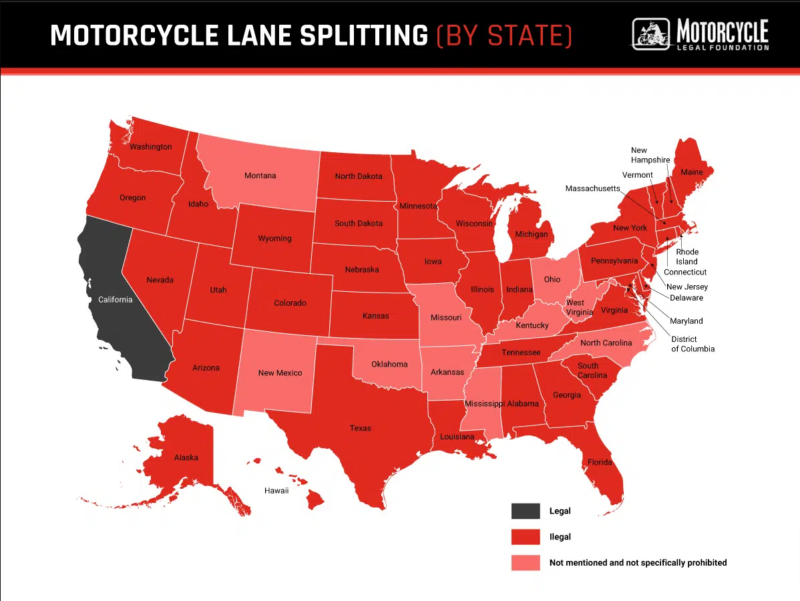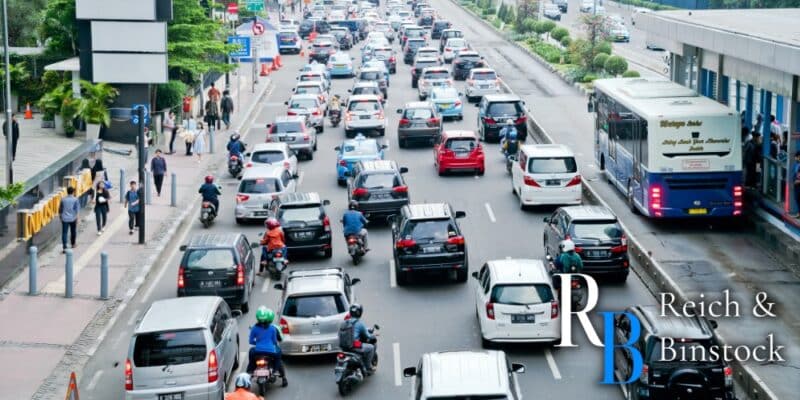Have you ever watched a motorcycle whizz by in the tight gap between the lanes of a highway? That’s called lane splitting, and it is a controversial maneuver frequently done by motorcyclists. But is lane splitting legal in Texas specifically? The answer is no, lane splitting is illegal in the Lone Star State.
In the United States, the legality of lane splitting has long been a point of contention. Many people consider riding a motorcycle between lanes in stop-and-go traffic to be risky. In fact, lane splitting is prohibited in the majority of states – and Texas is no exception.
Reich & Binstock is here to provide you with top-notch legal services if you’ve been involved in a motorcycle lane splitting accident. Our experienced Houston motorcycle accident attorneys help you get the compensation you deserve. To schedule a free consultation about your case, please call our office at 713-622-7271 today.
What Is Lane Splitting?
When a motorcycle passes one or more vehicles in the region between two lanes, it is known as lane splitting. Motorcyclists typically use lane splitting to avoid having to stop in heavy traffic.
During moments of high traffic, this maneuver may be safer for motorcyclists than riding in a lane. That’s according to research conducted by the University of California Berkeley.
Motorcyclists are more likely to be hit from behind by cars, according to the study. Lane splitting reduces the danger of a rear-end collision for motorcyclists passing between lanes. Furthermore, most lane splitting happens at speeds less than 50 mph. Injuries are frequently less serious when traveling at these speeds.
What Is the Difference Between Lane Splitting, Lane Filtering, and Lane Sharing?
While the terms lane splitting, lane filtering, and lane sharing are sometimes used interchangeably, they refer to three distinct activities that motorcyclists can take on the road.
Lane Splitting
Operating a motorcycle between rows of stopped or moving automobiles in the same lane is known as “lane splitting” or “white lining.” In Texas, lane splitting is unlawful, but many states have no laws prohibiting it. Only California has passed legislation allowing lane splitting.
Lane Filtering
Utah was the second state to allow lane filtering in 2019. Moving “across two lanes to the front of vehicles halted at a junction” is legal, according to the Utah Department of Public Safety. In other words, when traffic comes to a halt at a stop sign or traffic signal, a motorcycle rider has the option of moving to the front of the line.
Lane Sharing
Lane sharing allows two motorcycles to ride side by side or in a staggered formation in the same lane. Two motorcycles may legally share a lane in Texas if they are positioned side by side.
Why Do Motorcycles Split Lanes?
According to the American Motorcyclist Association, lane splitting keeps motorcycle riders safer since it allows them to pass between vehicles in traffic, offering them an escape path in congested areas. Not stopping in slow-moving traffic is usually a good idea for riders. Many motorcycle accidents happen when a car doesn’t see a motorcyclist until it’s too late.
Safety should be every rider’s top priority, but what other reasons do motorcyclists have for lane splitting or filtering?
Supporters of lane splitting argue that it keeps traffic moving by allowing vehicles and trucks to fill in the gaps left by motorcycles. Motorcycles can move out of line and close gaps that are both dangerous for them and inconvenient for other drivers.
Where Is Lane Splitting Legal?
Several bills to legalize lane splitting have been introduced in various states over the years. However, lane splitting laws are different from state to state. It is legal in California. Although it is technically illegal in Hawaii due to the narrowness of the roadways, the state has allowed shoulder-surfing during traffic congestion. Lane filtering is permitted in Utah. Lane filtering, while not as permissive as lane splitting, can assist motorcyclists in avoiding being tailgated while on the road.
Meanwhile, lane splitting or lane filtering legislation is pending in Virginia, Washington, Oregon, Connecticut, and Arizona.
Map of motorcycle lane splitting by state from the Motorcycle Legal Foundation, as of January 2024.
Lane Splitting Legal States
California is the only state that has made lane splitting lawful. Governor Jerry Brown signed California Assembly Bill 51 into law in 2016. After legalizing lane splitting, motorcycles were allowed to drive “between rows of stopped or moving vehicles in the same lane.”
In fact, the California Highway Patrol actually works with motorcycle safety groups to develop best practice guidelines. For example, these guidelines state that riders are recommended to avoid lane splitting if traffic is moving faster than 30 mph.
All other states have made lane splitting, often known as “white lining,” illegal. However, several states are considering (or have already passed) legislation to legalize the act or comparable behavior, such as lane filtering and lane sharing.
States That Allow Lane Filtering
The following states allow motorcyclists to lane filter under certain circumstances.
- Hawaii
- Utah
- Arizona
- Montana
- California (where the practice is legal)
States Where Lane Splitting Is Not Illegal
Many states simply have no laws that specifically prohibit lane splitting. Even though the practice isn’t technically illegal in these states, police officers could still pull over lane splitting motorcycle riders to issue a citation. The following states do not have specific laws prohibiting lane splitting.
- New Jersey
- Mississippi
- Missouri
- Arkansas
- Idaho
- Ohio
- North Carolina
- Delaware
- Kentucky
- West Virginia
States Considering Legalizing Lane Sharing
The following states are considering or have considered making lane splitting a legal practice.
- Connecticut
- Massachusetts
- Washington
- Maryland
- Virginia
- Missouri
- Oregon
Texas Lane Splitting Laws
As of September 1st, 2023, both lane splitting and lane filtering became illegal in the state of Texas. Introduced earlier in the year during the Texas State Legislative Session, House Bill 4122 specifically prohibited operating motorcycles between lanes of traffic. It also outlawed motorcycles passing other vehicles in the same lane moving in the same direction. HB 4122 was signed by both the state House and state Senate in May 2023. It was then signed into law in June 2023 and went into effect in September 2023.
Lane Splitting Texas
Motorcyclists zip by other drivers in various spots across the country by riding between lanes and gaps in traffic. However, lane splitting, often known as lane sharing, is unlawful according to the Texas transportation code.
All drivers and motorcyclists are required to drive in a single lane under Section 545.060 of the Texas Transportation Code. Motorcyclists may change lanes but not drive between them on roads separated into “two or more clearly indicated lanes.”
A fine of at least $175 is the penalty if you’re caught breaking road safety laws in Texas. Citations for speeding, reckless driving, improper lane changes, and tailgating are possible penalties for motorcyclists who break the law.
Is Lane Splitting Safe?
Motorcyclists say they lane split for speed and safety.
When it comes to speed, lane splitting allows motorcycles to travel quickly and efficiently through traffic. As a result of lane splitting, there are less vehicles on the road.
Motorcyclists contend that lane splitting makes them safer and less likely to be involved in a rear-ended accident with a larger vehicle. Distracted drivers frequently rear-end automobiles in front of them when traffic comes to a halt.
Even if a motorcycle is struck from the rear at a low speed, the rider is likely to be critically hurt or killed. Life-altering injuries such as traumatic brain injuries, spinal cord damage, fractures, and organ damage are common injuries suffered by motorcyclists after a wreck.
Critics of lane splitting, on the other hand, contend that motorcyclists fly between cars in ways that frighten drivers and put them in unsafe situations.
Whether lane splitting is safe or not depends on how it is done. Typically, when it’s done at a speed of 10 mph or slower, lane splitting is safe. It is unsafe when performed at speeds greater than 30 mph.
Is It Legal for Motorcycles to Split Lanes in Texas?
No. Riders cannot legally lane split between marked lanes in the state of Texas. Prior to House Bill 4122 becoming law, the practice was not explicitly illegal. However, the practice was formally outlawed when the bill became law and went into effect in September 2023.
Who Is Liable for a Lane Splitting Accident?
In Texas, if you split lanes, you could be held accountable for any accidents that occur. Especially if traffic is traveling faster than 30 mph or if you are careless while splitting lanes.
However, drivers who engage in behavior that is more dangerous or unlawful than lane splitting may be held liable. For example, if you were hit by a drunk or inattentive driver while riding your motorcycle, or if someone changed lanes without using their signal or checking their blind spot. You may be eligible for reimbursement from the at-fault motorist’s insurance carrier.
Penalties
If a highway patrol officer pulls you over in Texas, you may face traffic violation penalties. A $175 fine is the typical penalty for lane splitting. Motorcyclists are classified in the same way as cars under Texas law, thus the same safety standards apply.
If a motorcycle accident happens as a result of lane splitting, the biker may be held liable since they drove recklessly.
Because Texas is a comparative negligence state, any compensation to which you are entitled may be reduced based on the amount of fault assigned to you.
Contact Reich & Binstock If You’ve Been Injured in a Motorcycle Accident
Lane splitting is banned in Texas, and all drivers must only change lanes when it is safe to do so. A motorist may be held accountable if he or she impacts a motorcycle while changing lanes or overtaking another vehicle.
If you were injured in a lane splitting accident, working with an attorney who is familiar with this sort of accident can be beneficial. Accountability is important to us at Reich & Binstock. Even if they claim you were at fault because you were lane splitting or lane filtering, we want to hold the responsible individual accountable for your damages.
Reich & Binstock are personal injury lawyers in Houston who provide free consultations to motorcycle accident victims. We explain the statutes that may apply to your situation if we believe you have sufficient proof of carelessness and culpability to pursue legal action. Call our staff at 713-622-7271 today to discuss your accident, injuries, prognosis, and other case details.


















